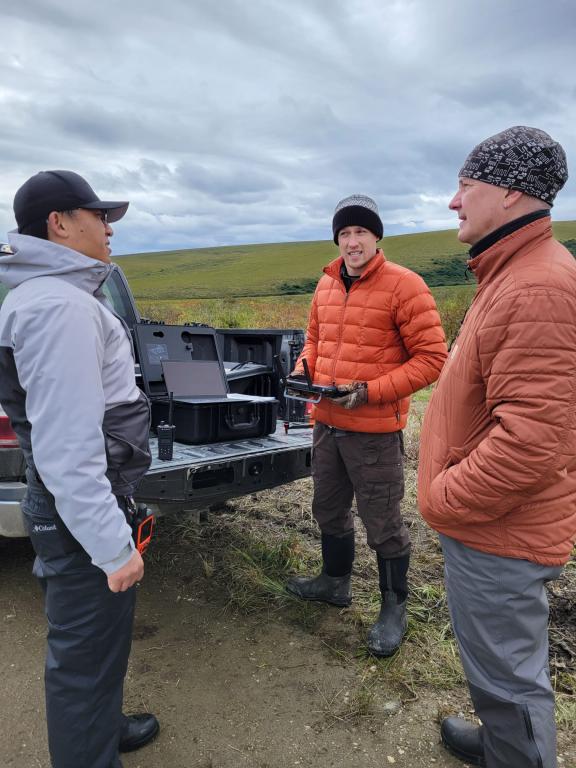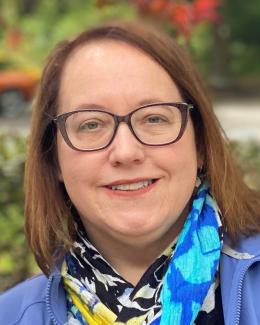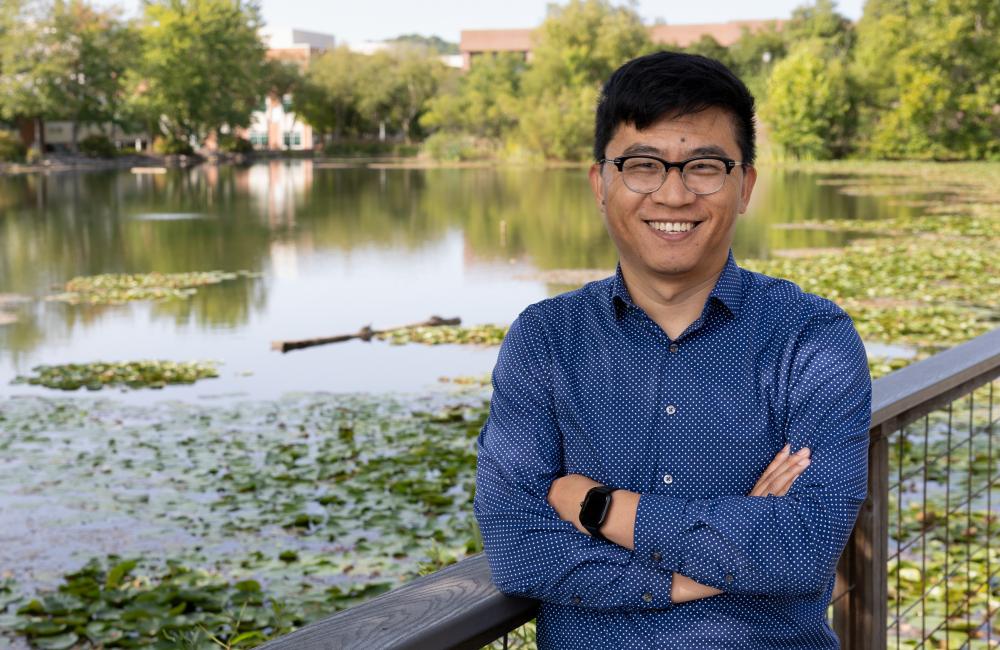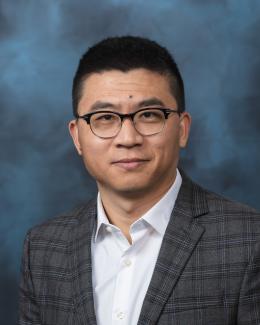Daryl Yang is a Liane B. Russell Distinguished Staff Fellow at ORNL focused on the development and deployment of remote sensing technologies and numeric models to better understand how the Arctic ecosystem is evolving under climate change. Credit: Alonda Hines/ORNL, U.S. Dept. of Energy
Daryl Yang is coupling his science and engineering expertise to devise new ways to measure significant changes going on in the Arctic, a region that’s warming nearly four times faster than other parts of the planet. The remote sensing technologies and modeling tools he develops and leverages for the Next-Generation Ecosystem Experiments in the Arctic project, or NGEE Arctic, help improve models of the ecosystem to better inform decision-making as the landscape changes.
Yang is a Liane B. Russell Distinguished Staff Fellow scientist in the Environmental Sciences Division at the Department of Energy’s Oak Ridge National Laboratory. As part of the ORNL-led NGEE Arctic project, Yang collects data about the Alaska tundra at scales ranging from the biome level with satellites, to the landscape level using drones, to the leaf level with ground sensors.
The goal is to better understand how Arctic ecosystems are changing as icy soil layers called permafrost melt, the land subsides, vegetation transforms and carbon long locked away in soils is emitted to the atmosphere in the form of greenhouse gases. Drones equipped with multispectral, hyperspectral, thermal and light detecting and ranging, or LiDAR, instruments can, for instance, capture how vegetation is evolving with unprecedent detail and track the sudden appearance of irregular terrain called thermokarst as permafrost thaws, which causes hazards for humans and wildlife.
Yang is leveraging machine learning to extract knowledge from those data, extrapolate them across scales and integrate the information into land models that are fed into the giant DOE Energy Exascale Earth System Model, which helps scientists better predict the future.
In addition to his work for NGEE Arctic, under his fellowship project, Yang is examining the impact of more frequent and widespread wildfire in the Arctic and across boreal, or subarctic, ecosystems. Fire disturbance in northern high-latitude regions is difficult to observe given the remote locations and extreme environments. Yang is developing remote-sensing methods to capture the impact of fire on both energy and carbon fluxes, looking at soil-land-atmosphere interactions that affect the carbon cycle — including whether wildfire is accelerating changes in both vegetation and climate.
“The Arctic is a very interesting environment to study,” Yang said. “Unlike big forest ecosystems where a lot of carbon is stored in trees, in the Arctic the carbon is in the soils. So you’re studying the environment at a much smaller scale, and finding a lot of complexity.” The Arctic is also rapidly evolving, causing more frequent and damaging disturbances such as landslides, wildfire and especially the thawing of permafrost that has for years insulated vast stores of underground carbon, he added.
“As the permafrost melts, it is fundamentally changing everything. Changes to the terrain, the emergence of new vegetation and changes in the life cycle of existing vegetation – these are all very important to the people and the animals who live in the Arctic,” Yang said.
Communing with trees in a changing climate
Yang traces his interest in the environment to a childhood spent on his family’s farm in the Shandong Province of China. He was fascinated by the family’s cherry groves, spending hours sitting under the trees, climbing them, and observing how different species changed with the seasons. “Those cherry groves were my best friends and taught me a lot about plants that laid a foundation for my interest in plant ecosystems,” he said.
As he grew older, Yang began to notice how the trees were stressed by a warming climate. They began flowering early – before bees were active and pollinating — and sometimes those early blooms were killed off by frost. Many of the trees eventually stopped producing much fruit at all.
As an undergraduate at Central South University in Changsha, Yang’s interest in the annual life cycle of trees, a field called phenology, continued. He earned a bachelor’s degree in surveying and mapping engineering. Yang continued his remote sensing research and deepened his knowledge of the “why” behind changing landscapes while earning a master’s in global environmental change at Beijing Normal University.
Yang then came to the United States to study ecology and evolution at Stony Brook University in New York. As part of his doctoral studies, he began to work in both tropical and Arctic ecosystems as a research assistant with scientists at the university and nearby Brookhaven National Laboratory. He spent 18 months as a NASA FINESST Fellow during his graduate studies, honing his skills in remote sensing, interpretation and data modeling with a grant from the program. He also engaged with NGEE Arctic during his time at Stony Brook.

“I was attracted to ORNL’s leadership in the NGEE Arctic project, as well as the lab being a world-leading research institution. ORNL leads DOE projects highly aligned with my interests, including a focus on high--latitude ecosystems,” Yang said. “I was trained as an Arctic boreal ecologist, and I want to keep growing my research with remote sensing in those regions, so the opportunity to work here helps me stay on that career path.”
He has enjoyed working on the NGEE Arctic team not just for the science opportunities, he said, but also for the camaraderie.
“The way the leaders of NGEE Arctic think about science, and the way they are caring toward everyone involved in the project has helped me grow as an individual, ” Yang said. “Leaders like Stan [Wullschleger] and Colleen [Iversen] at ORNL, and all the researchers involved, care about early career scientists and try their best to promote them. They have really helped me grow my science.”
In the long term, Yang is interested in developing advanced, cross-scale remote sensing technologies, particularly drone-enabled hyperspectral and thermal remote sensing. This work can help researchers better observe and understand ecosystems, and track and predict their response to climate change. “Advancing a multiscale capability at ORNL can not only support our own projects, but can boost science in general through our connections with other institutions,” he said.
He’s also interested in building tighter connections between researchers and the communities they work in that are threatened by climate change, with the goal of providing scientific information and technologies to help communities deal with increasing geohazards. As NGEE Arctic liaison to the Interagency Arctic Research Policy Committee, or IARPC , he is collaborating with other scientists to organize a workshop to better understand and explore current research gaps that would benefit at-risk communities.
Advice, and a message of hope, for young scientists
Away from the lab, Yang enjoys fishing with his young son, taking nature walks and teaching him how to play basketball. Yang is a drone enthusiast at home, too. He has three drones of varying sizes and enjoys capturing footage of the changing seasons in Tennessee. The Oak Ridge area experienced a heavy snowstorm just after his family moved here in January 2024. “We were snowed in for a few days, but I ended up making progress on a couple of fronts — capturing some dramatic winter scenery with the drones, and writing a research proposal.”
His advice for young scientists?
“My top advice would be to align your interests with your professor’s projects and missions,” he said. “Sometimes Ph.D.s go off and design their own independent research projects. But working on a big multidisciplinary team gives you the opportunity to learn from researchers with different expertise and to network and grow your own interests.
My second bit of advice is to be persistent, but flexible. Learn from the feedback you get and be flexible in your science and your approach. Don’t be shy in asking for feedback. It’s important to help you grow.”
What keeps Yang motivated in his work is hope. “My son is turning four soon. I’ve been teaching him about science at his level, about plants and forests and the changing seasons,” Yang said. “Teaching him reminds me how important it is that we bend the curve of climate change to provide a better future for the next generation.”
UT-Battelle manages ORNL for DOE’s Office of Science, the single largest supporter of basic research in the physical sciences in the United States. The Office of Science is working to address some of the most pressing challenges of our time. For more information, please visit energy.gov/science




